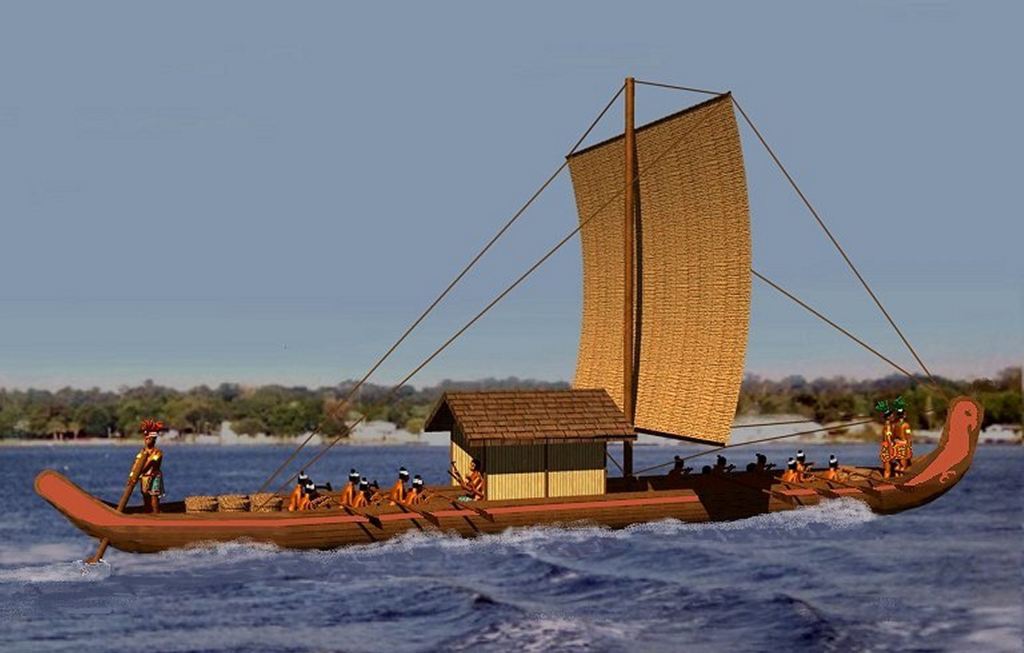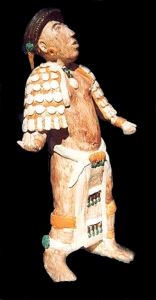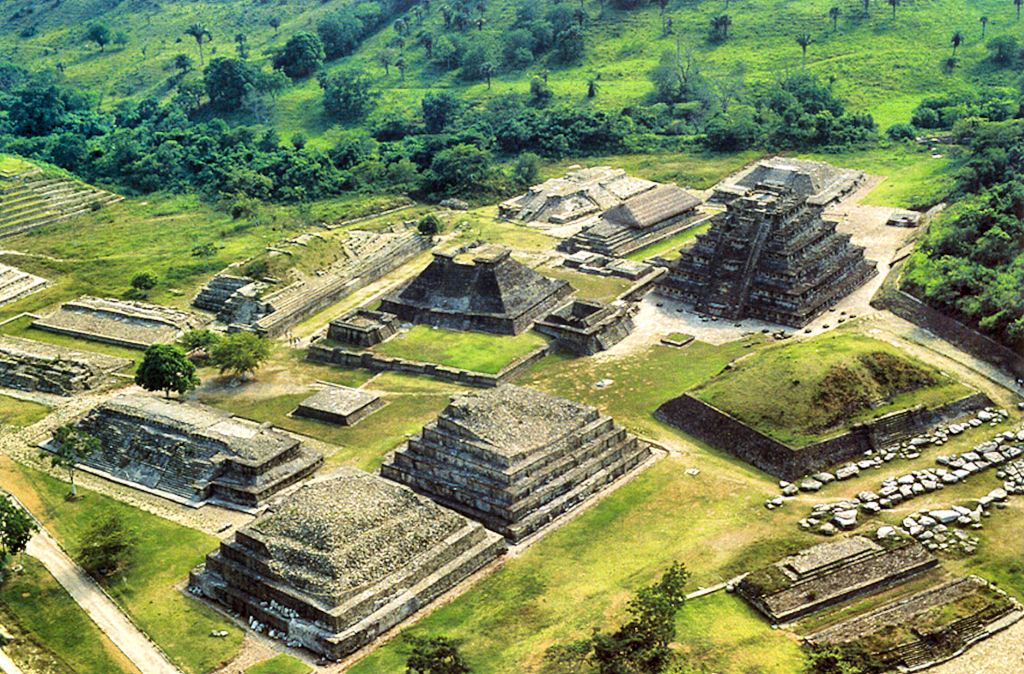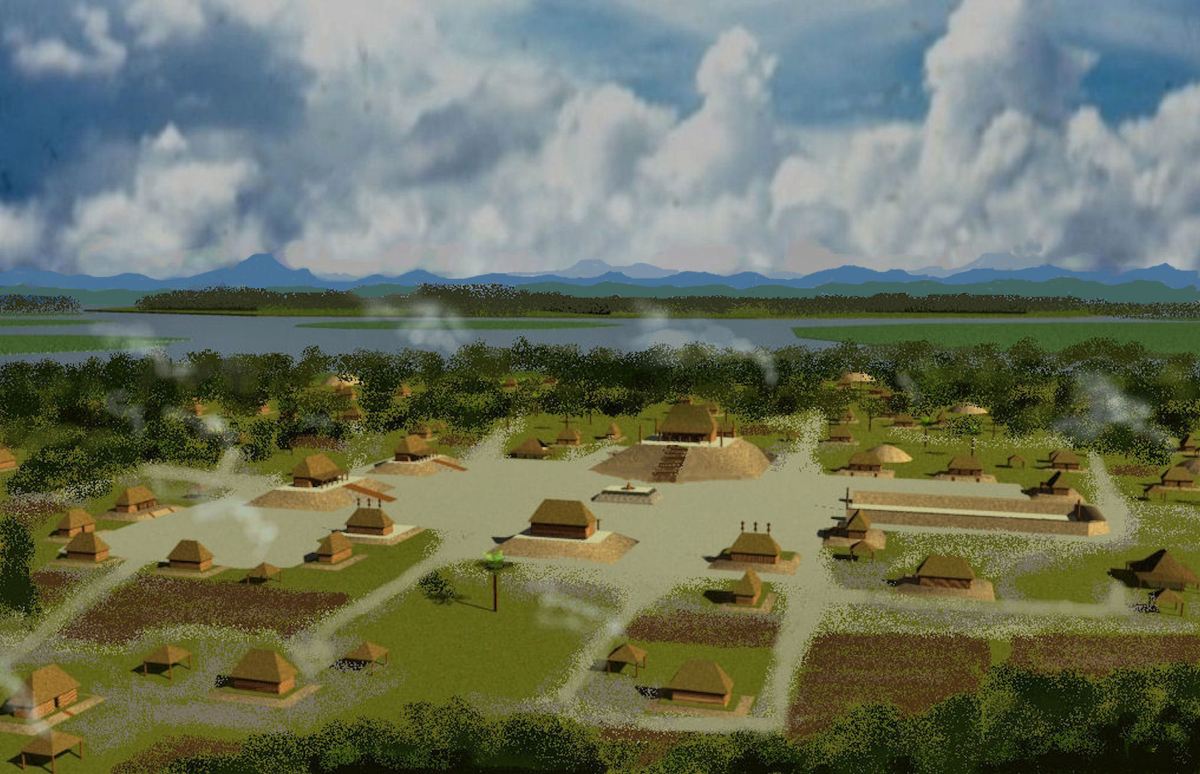by Richard L. Thornton, Architect & City Planner
Tamaulipas – Veracruz – Tabasco – Chiapas
One Summer in Mexico – Part 38
The problem began with the superficial treatment of Mexican history in North American textbooks. It was made far worst by the general lack of knowledge about radical ethnic and cultural changes that occurred in both the Southeastern United States and Mexico around 3200 years ago . . . and again between 800 AD and 1200 AD. Laymen and academicians also seem to be unaware that the Mexica (Aztecs) were carrying out ethnic cleansing programs in the Gulf Coast region when the conquistadors of the Hernan Cortez Expedition invaded Mexico. That was followed by a European Disease Holocaust, which killed off about 90-95% of the population of Mexico.
Most North Americans have a vague understanding of Mexico’s past, equivalent to or less than a sixth grade Social Studies textbook. They know that the “Aztecs and Mayas” lived somewhere “down there” and presume that the occupied the entire boundaries of Mexico. They are unaware that the “Maya Civilization” consisted of well over a hundred ethnic groups, who didn’t call themselves Maya . . . and that the Aztecs were Late Arrivals from the north.

An overview of a complex subject
An adequate coverage of the Mexican Gulf Coast Cultures would require a large book on each culture. I will be producing videos on those Gulf Coast cultures, which I actually studied in Mexico. I did NOT visit any Huastec or Ocampo town sites. In the meantime, I thought that it would be appropriate to provide background understanding and an overview of each major culture.
The most important fact for readers to know is that there was an apocalyptical ethnic change in Mexico between around 800 AD and 1200 AD. The initial ethnological cataclysms were caused by the explosion of the EL Chichón and Xocotépetl Super-volcanoes. El Chichón incinerated Palenque and caused the mass-emigration of Itza Mayas from Chiapas. Xocotépetl caused the abandonment of the Toluca Basin and a mass-emigration out of the Valley of Mexico . . . thus leaving the region open to reoccupation by Nahuatl-speaking Chichimeca tribes.
Around 900 AD, waves of Nahuatl-speaking tribes and bands began sweeping southward from the desert lands and prairies of what is now the Western United States and Northwestern Mexico. In some regions, the newcomers settled among indigenous peoples. However, in central Mexico and along the Gulf Coast the change was much more violent. Entire ethnic groups were exterminated, subjugated or driven out of Mexico. The Soque (Sokee)-Miccosukee Migration Legend specifically states that their ancestors left southern Mexico because of savage invaders from the north.
At the same time that many thousands of culturally-advanced peoples were pouring out of Mexico, there were three distinct periods of new, culturally-advanced towns being founded in the Southeast and Mississippi River Basin.
(1) Between 800 AD and 900 AD, people cultivating corn on a large scale appeared on the Ocmulgee River in Middle Georgia and in the Georgia Gold Belt in northern Georgia. Many new towns and villages also appeared near Lake Okeechobee, but they were not primarily agriculturalists.
(2) Around 1000 AD a tidal wave of new towns and villages appeared at many locations in the lower Southeast and Mississippi River Basin.
(3) Around 1200-1250 AD, many of the earliest towns were abandoned in the Southeast, while many new ones were founded or resettled on old town sites.
Architecture and community planning
In a 1200-mile swath southward from Tampico Bay, Tamaulipas to eastern Guatemala, there was absolutely no difference between the rural villages of Mesoamerica and the rural indigenous villages and hamlets of the Lower Southeast. Any style of house or communal building, found in that corridor of Mesoamerica can also be found in the Southeast. The corner door houses in the suburbs of Chichen Itza were also being built at the same time in Etula (Etowah Mounds). The types of houses found at the Long Swamp Creek Mounds town site on the Upper Etowah River in Georgia are built to this day by the Totonacs.
In the upper 75% of the Gulf Coast Culture corridor, the vast preponderance of public structures are earthen mounds and ceremonial earthworks. One also sees five sided earthen mounds and sculptured hills in the regions in the southern section, once occupied by the Itza Mayas and their kin. Earthen mounds and ceremonial earthworks of all sections of the Gulf Coast Culture Corridor can be found in the Creek Homeland. In fact, the only two places in the world where five sided ceremonial mounds are found are in the homelands of the Itza Mayas, Kekchi Mayas and Creeks.
There were exceptions to the rule in the Gulf Coast Corridor. There were some large cities in northern Veracruz, Chiapas and Guatemalan Highlands, which constructed stone masonry architecture. The pyramids consisted of earthen cores with fieldstone veneers, usually covered with lime stucco. The buildings were constructed of fieldstones or stone rubble with lime mortar and lime stucco coatings. However, about 90% of the population lived in far less sophisticated and little different in appearance than ancestral Creek villages.
There was exception in the Creek Homeland also. Oval mounds and oval plazas in Georgia predated ANY public architecture in Mexico. Mesoamerican-style rectangular or pentagonal earthen pyramids and rectangular plazas dominated the Creek Homeland from around 600 AD to 1375 AD. However, the oval pyramids and oval plazas reappeared after that date and typified all major towns within the Apalache Kingdom, which anthropologists call the Lamar Culture. I never saw any round or oval plazas in pre-Columbian Mexico. The only oval pyramids were in the hilly Puuc region of southern Yucatan and eastern Campeche.
Etymologies
Tamaulipas: Look up the meaning of the word Tamaulipas in either an English or Spanish language Wikipedia. Tamaulipas is a Mexican state on the Gulf Coast, adjoining Texas. Until recently the etymology was said to be unknown. Now some anonymous person has entered this non-sensical and actually false explanation: “The name Tamaulipas is derived from Tamaholipa, a Huastec term in which the tam- prefix signifies “place (where)”. … No scholarly agreement exists on the meaning of holipa, but “high hills” is a common interpretation.”
What? . High hills are entirely different words in Huastec. Tamaholipa means “Town of Liars” in Huastec, Choctaw and Chickasaw, but that is probably irrelevant Actually, there is no Spanish colonial document, which spells the word Tamaholipa. Also, among Muskogean and Maya peoples the V or “au” sound is a different letter than the “a” sound. That is significant.
Tamaulipas in Muskogean letters would be written Tamv-re-pas. It means “Trade – People – Place of” in Chontal and Itza Maya. The “re” is rolled so hard that English and French speakers wrote it as a “le” or “li.” Here is what is interesting. “Re” is the archaic Irish (pre-Indo-European NW Europe) word for a kingdom or a tribe with a formal government. It is found in many Irish, Scottish and Welsh place names. It is also found in the Uchee language of eastern Georgia.
Veracruz: Veracruz is obviously the Spanish words Vera Cruz, which mean “True Cross.”
Tabasco: The origin of the name Tabasco is not definitively known, with a number of theories debated among linguists. The name appears in the chronicles of Bernal Díaz del Castillo during the conquest era, who mentions a river named after local ruler Tabscoob. In the early 1600s, the Spanish called this district Tavasco. The first definition listed in the 1994 Diccionario enciclopédico de Tabasco was from the Olmeca (Nahuatl) name of the area, tlapalco meaning “(place of) damp earth.” Wetlands are still extensive in the Mexican state of Tabasco.
Other possible etymology is that it comes from a Mayan phrase meaning “our lord of the eight tigers”. Another states that it is from Nahuatl with two possible derivations: one meaning “place that has a lord.”
Chiapas: Chiapas is an Itza Maya word, which means “Chia (grain salvia) – place of.” It is closely related to the Creek tribal name, Chiaha, which is also Itza Maya and means “Chia-River.”
Major Indigenous Ethnic Groups in Gulf Coast Cultural Region
(Nahuatl-speaking tribes are not considered indigenous)

(1) Mia or Maia – First, it should be explained that only one tribe, classified as Maya today, called themselves Maya and they originated in southern Florida. They actually called themselves the Mia (Island) People. Mia is also the Creek word for island. Their territory was called Miam or “Mia-place of.” There was a Miam in SE Florida and a Miam in north central Yucatan. Like other Gulf Coast Culture peoples, they principally built earthen mounds, but at their capital of Mayapan, where they were ruled by a Central Mexican elite, they constructed refined stone architecture.
The principal Mia homeland in Florida was called Miami or principal Land of the Maya. The Spanish change Mia to Maia and applied that name to all tribes in the Yucatan Region. The Mia spoke a language similar to that of the Tabasco Mayas, but closely related to Itza Maya.

(2) Itza (Itzate) and Kekchi Maya (+ related smaller tribes) – Although they live in the Chiapas, Guatemalan and Belize Highlands, these ethnic groups are culturally part of the Gulf Coast Region, since they primarily built earthen pyramids or mounds. They also built many terrace complexes. Their physical appearance and language are different than those descended from the branches of the Mayas, who built larger cities.
According to Classic Period Maya texts (200 AD-900 AD), the Itza had an aboriginal language that was very different than Maya. Only the priests and highest rulers remembered this language. The Itzas were conquered by an army from Teotihuacan around 200 AD. From then until around 600 AD, they were ruled by princes from Teotihuacan, who spoke Totonac. Several Totonac words entered the Itza language during this period, which later were absorbed by Creeks in the Southeastern United States.


(3) Tamaule or Tamaute – This tribe is closely related to the Itza. Their name means “Trade People” in Itza Maya. They probably originated near the mouth of the Usumacinta River, which serves as part of the border between the states of Tabasco and Campeche.
At some point in the past, many of the Tamaule migrated by sea to what is now the State of Tamaulipas, giving that region their name (Tamauli-place of). When attacked by Chichimeca tribes between 1200 and 1250 AD, many of the Tamauli fled northward and eastward along the Gulf Coast. One band returned to their homeland and joined with the remnants of their tribe, where they live today. The Spanish call them Tamulte.

(4) Zoque, Soque or Sokee – In the Pre-Columbian times, the Zoque lived throughout Chiapas, and Isthmus of Tehuantepec and parts of the state of Tabasco. They claim to be the progenitors of the so-called Olmec Civilization. The Soque-Miccosukee Migration Legend also stated that their ancestors founded the first great civilization in Mesoamerica. This legend stated that the Zoque participated in the Maya civilization, but that the Zoque maintained their own cultural identity. The ancestors of the Southeastern Soque and Miccosukee departed Tabasco, when the region was invaded by Nahuatl armies from the Valley of Mexico in search of captives to be sacrificed to their gods. This occurred around 1250 AD or later. The legend stated that the Soque refugees gathered members of other oppressed tribes as they fled northward along the edge of the Gulf of Mexico to the mouth of the Apalachicola-Chattahoochee River.
Wikipedia incorrectly states, “They are hypothesized to be the descendants of the Olmec. They had a good social and commercial relationship with the later Mexica, which contributed to the economic prosperity of their culture in Chiapas. In 1494 they were invaded and defeated by the Aztecs, during the reign of Ahuizotl, and forced to pay tribute.”
The Olmeca is a Nahuatl tribe that settled in the Zoque lands after around 1000 AD. They had nothing to do with “Olmec” Civilization, which began around 1700 BC. It is highly possible that the same people, who founded the “Olmec” Civilization also founded the large town of Poverty Point in northeastern Louisiana.
(5) Popoluca – This cluster of tribes in northern Oaxaca and southwestern Veracruz was part of a Mixi-Zoque language group. These Populuca are essentially a branch of the Soque. However, the tribal grouping also included some tribes that spoke the unrelated Maztecan languages. The Maztecan languages are based on tones, so that it is possible to transmit complex thoughts by whistling. Maztecan whistle speakers tend to be young adult and teenage men.
(6) Chontal or Cho’i-te Maya – The Chontal Maya originated in Tabasco. A typical Chontal Maya town is pictured at the top of this article. It was very similar to the Swift Creek and later smaller villages in Georgia. The ball courts were off to the side and different in geometry than the ball courts of other peoples on the Gulf Coast in in the Creek Homeland.
The Chontal originally lived on the marshy islands near the Gulf Coast in a region almost identical in appearance to the coasts of Georgia and South Carolina. They developed increasingly more sophisticated skills in navigation, which enabled them to become the consummate traders of much of Mesoamerica. The Chontal Maya learned how to build large wood plank boats with sails that were similar in size and performance to the Viking longships.

After around 900 AD, they spread their trading center ports along the coasts of all of Mesoamerica. Bottle Creek Mounds near Mobile Bay, Alabama.

“Chontal”, is derived from the Nahuatl word chontalli, which means “foreigner”, has been applied to various ethnic groups in Mexico. The Chontal refer to themselves as the Yokot’anob or the Yokot’an, meaning “the speakers of Yoko ochoco” (language or dialect) but Mexican writers refer to them as the Chontal of Centla, the Tabasco Chontal, or in Spanish, Chontales. They consider themselves the descendants of the “Olmec” Civilization, and are not related to the Oaxacan Chontal.
(7) Potan or Putan Mayas – Some Chontal Mayas became especially wealthy and politically powerful. They established governments of city states in Yucatan, which were ruled by elected councils and an elected king. This elite merchant class was known as the Potan or Putan. It is highly likely that the Potano Tribe in northern Florida was descended from the Potan Mayas.

(8) Tekista or Tequista – They were a tall, lanky Tolteca people, living in southwestern Veracruz in the vicinity of the Orizaba Volcano. Mexican anthropologists are coming to believe that the predominant ethnic group in the Valley of Mexico – Cuernavaca area prior to the arrival of the Nahuatls were Toltecas, such the Teskita. The Mexica particularly hated them and hunted them for food . . . under the guise of sacrificing them to the gods. There is little doubt that the original name of the Kaushete (i.e. the Creek Migration Legend) was Teskita, since they were originally from the slopes of the Orizaba Volcano. It is probable, but not certain that the Teskita of southeastern Florida were the same ethnic group as the Teskita of Mexico.

(9) Totonac – This is one of the most advanced and largest indigenous ethnic groups in Mexico that today resides in northern Veracruz, Puebla and Hidalgo states. Totonac probably means “three hearts,” but an earlier name for them, still used by neighboring tribes, meant, “People from where the sun rises,” which is exactly the meaning of the aboriginal name of the Uchee People in the Southeastern United States. In other words, they are from the other side of the Atlantic Ocean, not from Siberia. They are known for their sophisticated stone masonry architecture. Their unique language furnished words to many other peoples, including the Muskogean tribes of the Southeastern United States.
Although located on the Gulf Coast and east central areas of Mexico, the Totonacs were really not part of the Gulf Coast Culture, which was typified by skilled copperwork, earthen mounds and rectangular, central plazas.
Nevertheless, the Totonac did play an important role in the emigration of many Gulf Coast bands out of Mexico. It is now known that when the Totonac composed the elite of Teotihuacan, they practiced human sacrifice on an industrial scale. Their victims (and ritualistic meals) were derived from the flesh of babies, children and youth, officially sacrificed to their rain, fertility and agriculture deities. The Kaushete Migration Legend states as the prime reason for leaving Mexico was that their children were being killed.

(10) Wastek, Teenek or Huastec – This little-known indigenous people today lives in the Mexican states of Hidalgo, Veracruz, San Luis Potosí and Tamaulipas, but are concentrated along the route of the Pánuco River and along the coast of the Gulf of Mexico. Judging from archaeological remains, they are thought to date back to approximately the 10th century BCE, although their most productive period of civilization is usually considered to be the Postclassic era between the fall of Teotihuacan and the rise of the Aztec Empire. Most of their pyramids were earthen and virtually identical to those in the Mississippi River Basin of the United States. They did construct some pyramids that were veneered with field stones, but these types of structures are also sometimes found in Georgia.
Pre-Columbian Wasteks had some cultural traits that set them apart from the other cultures in Mesoamerica and the Southeastern United States. They did not cultivate or eat maize. Except in the coldest months, they wore practically no clothes, so never developed skills as weavers. Yet, they were considered the best musicians in Mexico.
DNA studies of the Wastek have discovered that they are closely related to the Zoque. Tabasco Mayas and Lowland Mayas. Linguists have approximated that the precursor to the language of the Huastecs diverged from the Proto-Mayan language between 2200 and 1200 BC.
About 1450, the Huastecs were defeated by Aztec armies under the leadership of Moctezuma I; the Huastecs henceforth paid tribute to the Aztec Empire but retained a large degree of local self-government. The Huastecs were conquered by the Spanish between 1519 and the 1530s. After the Spanish Conquest, many Huastecs were sold as slaves in the Caribbean by the Spanish. The ancestors of the Choctaw were evidently in close contact with the Wastek. There are several shared words between the two languages. Here is a good example. Tama means “trade” in Totonac, Itza Maya, Kekchi Maya, Cho’i-te Maya, Zoque, Itsate Creek and Koasati. Tama means “town” in Wastek, Choctaw, Chickasaw and Kanza (Kaw). Obviously, that meaning of tama came from the fact that trading places evolved into villages then towns.
(11) Extinct tribes – Mexican anthropologists are convinced that at one time there were several more major tribes along the Gulf Coast, because there are ruins in the region, which seem to have no cultural connection to known ethnic groups. The five main periods of abandonment are:
- c. 200 AD – when armies from Teotihuacan expanded its empire to most of Mesoamerica
- c. 1000-1100 AD – when bands of Chichimec barbarians began invading the Gulf Coastal Plain
- c. 1150-1250 AD – when Chichimecs took complete control of the Valley of Mexico, plus conquered the Totonac capital of Tajin, the Toltec capital of Tula, plus occupied the coastal plain of Tamaulipas.
- c. 1400-1500 AD – when Mexica armies subjugated most of the Gulf Coastal Plain, forcing survivors to pay tributes.
- 16th century – when European diseases swept through Mexico.
The Pre-Columbian history of Mexico and the Southeastern United States continues to be an unfinished book. Almost every year, discoveries are made, which change our understanding of the past.

Howdy, Absolutely LOVE that Town of Liars!!!!!!!!!!!!!!
On Sun, Sep 13, 2020 at 9:18 AM The Americas Revealed wrote:
> alekmountain posted: ” by Richard L. Thornton, Architect & City Planner > Tamaulipas – Veracruz – Tabasco – Chiapas One Summer in Mexico – Part 38 > The problem began with the superficial treatment of Mexican history in > North American textbooks. It was made far worst” >
LikeLike
Richard, Great article. Did your find a connection with the Monte Alba and Tajin Totonac Architecture? Seems to be the same type found at Teotihuacan. The term “Puan” name was a old name for the Fox river (1638 map) in Wisconsin believed to be a connection with the Winnebago Sioux people. Likely a connection to the Chontal Putan people. Mandan people are believed to have lived in Wisconsin and likely some lived in North Georgia… “Nearby Siouan speakers had exonyms similar to Mantannes in their languages, for instance, Teton Miwáthaŋni or Miwátąni, Yanktonai Miwátani, Yankton Mawátani or Mąwátanį, Dakota Mawátąna or Mawátadą, etc.” (Notice the Tani / Tana) connection with Hi-Tani river? This “Tani” term seems to be a connection to Bronze age Sea tribes on both sides of the Atlantic. If we add a T to the end we have “Tanit” Sea goddess of the Carthaginians.
LikeLiked by 1 person
The individual temples share similar details, but the Zapatecs created enclosed rectangular plazas by surrounding them with pyramids and temples. The Totonacs built their temples in a random pattern.
LikeLiked by 1 person
https://www.ancient-origins.net/news-history-archaeology/phoenician-wine-0014257
Richard, A almost exact match for stone works of the Anasazi in some of their kiva’s ? There does seem to have been some Phoenicians among the Native peoples.
LikeLiked by 1 person